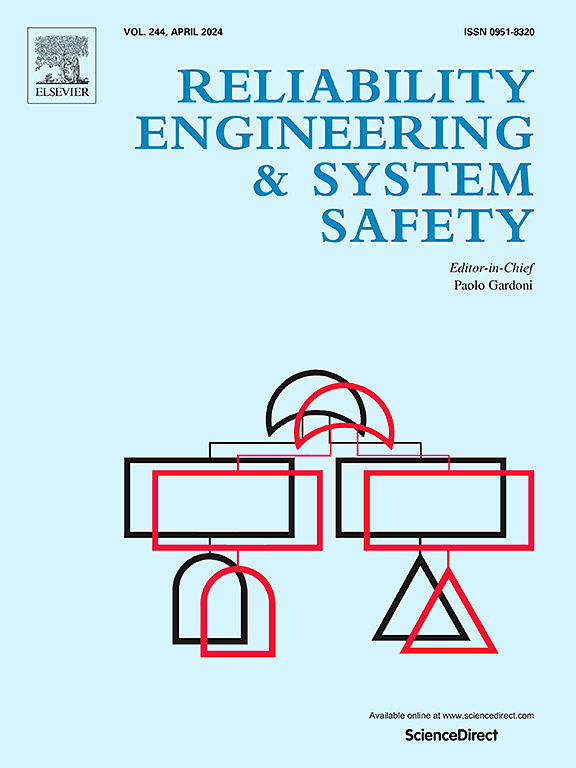Enhancing risk perception by integrating ship interactions in multi-ship encounters: A Graph-based Learning method
IF 9.4
1区 工程技术
Q1 ENGINEERING, INDUSTRIAL
引用次数: 0
Abstract
The navigation safety of autonomous surface ships depends on risk perception and avoidance in advance, which is based on accurate trajectory prediction of other ships. Sequential neural networks in deep learning have demonstrated reliable predictions in navigation scenarios with limited multi-ship interactions. However, accurately predicting trajectory changes caused by ship interactions remains challenging, as these predictions are based on mutually independent historical trajectories. In multi-ship encounters, trajectory predictions that lack interaction considerations can cause subsequent risk perception away from the actual future risk, thereby compromising navigation safety. In this study, we propose a method, the Graph-based Learning model for Risk Perception (GLRP), for risk perception based on interactive trajectory prediction. It introduces a variational graph auto-encoder to simulate the uncertain actions of ships in interactive environments, and takes the self-attention block to learn global time dependencies. GLRP establishes a learning channel from ship interactions to ship trajectories, allowing predictions based on exchanged trajectory inputs. The experiments indicate that GLRP reduces the distance to the closest point of approach error by 5. 45% and the time to the closest point of approach error by 4. 85% compared to individual sequence models. It improves navigation safety by enhancing the reliability of risk perception. The implementation code of this work is available at: https://github.com/KaysenWB/RESS_GLRP.
通过整合多船碰撞中的船舶交互来增强风险感知:基于图的学习方法
自主水面舰艇的航行安全依赖于对风险的提前感知和规避,而风险感知和规避是基于对其他舰艇的准确轨迹预测。深度学习中的序列神经网络已经在有限多船交互的导航场景中证明了可靠的预测。然而,准确预测由船舶相互作用引起的轨迹变化仍然具有挑战性,因为这些预测是基于相互独立的历史轨迹。在多船碰撞中,缺乏相互作用考虑的轨迹预测可能导致后续风险感知偏离实际未来风险,从而损害航行安全。在本研究中,我们提出了一种基于交互轨迹预测的风险感知方法——基于图的风险感知学习模型(GLRP)。引入了变分图自编码器来模拟船舶在交互环境中的不确定性行为,并采用自关注块来学习全局时间依赖关系。GLRP建立了从船舶相互作用到船舶轨迹的学习通道,允许基于交换的轨迹输入进行预测。实验结果表明,该方法将最接近点距离误差减小了5倍。45%,到最近接近点的时间误差为4。85%与单个序列模型相比。它通过提高风险感知的可靠性来提高航行安全性。这项工作的实现代码可在:https://github.com/KaysenWB/RESS_GLRP。
本文章由计算机程序翻译,如有差异,请以英文原文为准。
求助全文
约1分钟内获得全文
求助全文
来源期刊

Reliability Engineering & System Safety
管理科学-工程:工业
CiteScore
15.20
自引率
39.50%
发文量
621
审稿时长
67 days
期刊介绍:
Elsevier publishes Reliability Engineering & System Safety in association with the European Safety and Reliability Association and the Safety Engineering and Risk Analysis Division. The international journal is devoted to developing and applying methods to enhance the safety and reliability of complex technological systems, like nuclear power plants, chemical plants, hazardous waste facilities, space systems, offshore and maritime systems, transportation systems, constructed infrastructure, and manufacturing plants. The journal normally publishes only articles that involve the analysis of substantive problems related to the reliability of complex systems or present techniques and/or theoretical results that have a discernable relationship to the solution of such problems. An important aim is to balance academic material and practical applications.
 求助内容:
求助内容: 应助结果提醒方式:
应助结果提醒方式:


